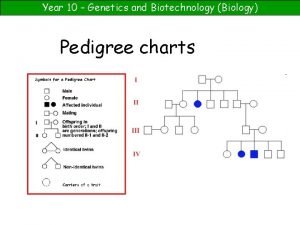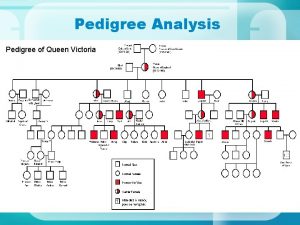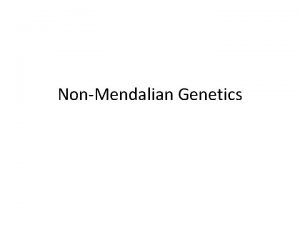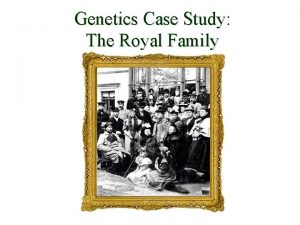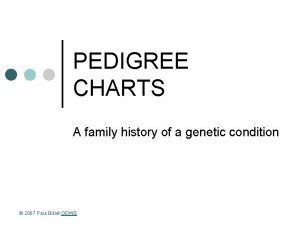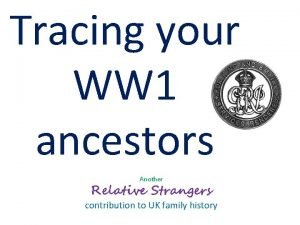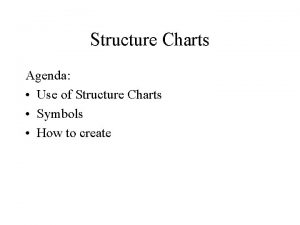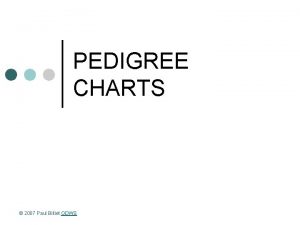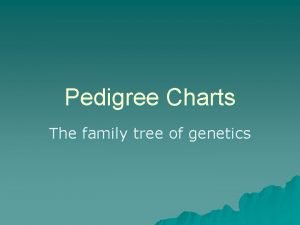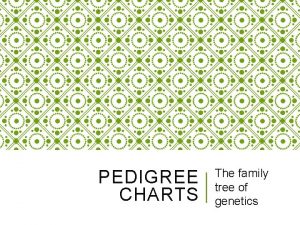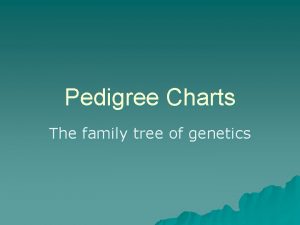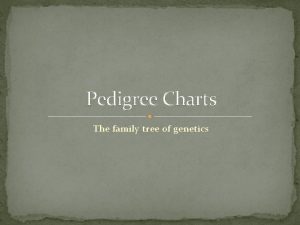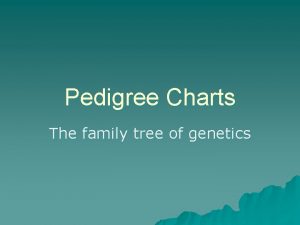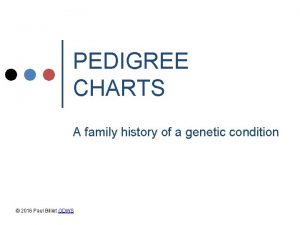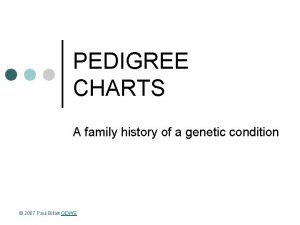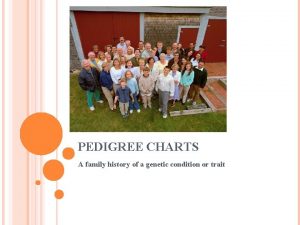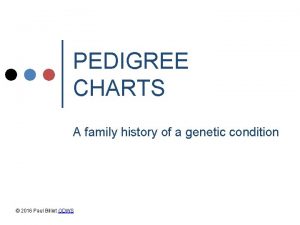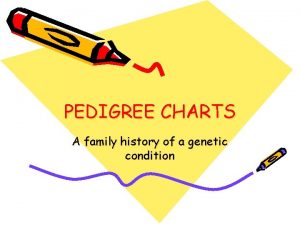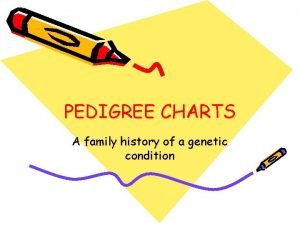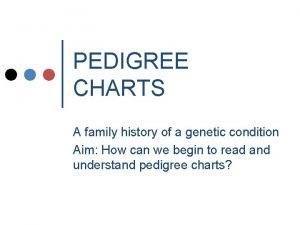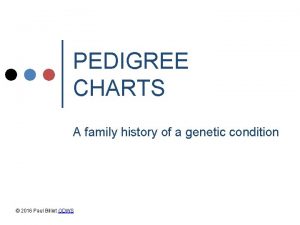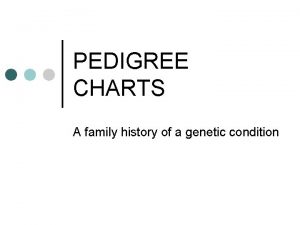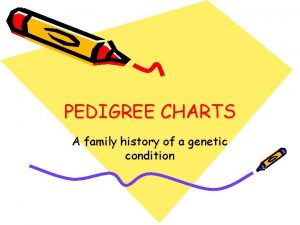PEDIGREE CHARTS A family history of a genetic




























- Slides: 28

PEDIGREE CHARTS A family history of a genetic condition © 2007 Paul Billiet ODWS

What is a pedigree chart? • Pedigree charts show a record of the family of an individual • They can be used to study the transmission of a hereditary condition • They are particularly useful when there are large families and a good family record over several generations. © 2007 Paul Billiet ODWS

Studying human genetics • You cannot make humans of different types breed together • Pedigree charts offer an ethical way of studying human genetics • Today genetic engineering has new tools to offer doctors studying genetic diseases • A genetic counsellor will still use pedigree charts to help determine the distribution of a disease in an affected family © 2007 Paul Billiet ODWS

Symbols used in pedigree charts • • • Normal male Affected male Normal female Affected female Marriage A marriage with five children, two daughters and three sons. The eldest son is affected by the condition. Eldest child Youngest child © 2007 Paul Billiet ODWS

Organising the pedigree chart • A pedigree chart of a family showing 20 individuals © 2007 Paul Billiet ODWS

Organising the pedigree chart – Generations are identified by Roman numerals I II IV © 2007 Paul Billiet ODWS

Organising the pedigree chart • Individuals in each generation are identified by Arabic numerals numbered from the left • Therefore the affected individuals are II 3, IV 2 and IV 3 I II IV © 2007 Paul Billiet ODWS

Today. . . Pedigree analysis v In humans, pedigree analysis is an important tool for studying inherited diseases v Pedigree analysis uses family trees and information about affected individuals to: vfigure out the genetic basis of a disease or trait from its inheritance pattern vpredict the risk of disease in future offspring in a family (genetic counseling)

Today. . . Pedigree analysis v How to read pedigrees v Basic patterns of inheritance vautosomal, recessive vautosomal, dominant v. X-linked, recessive v. X-linked, dominant (very rare) v Applying pedigree analysis - practice

Sample pedigree - cystic fibrosis male female affected individuals

Autosomal recessive traits • Trait is rare in pedigree • Trait often skips generations (hidden in heterozygous carriers) • Trait affects males and females equally

Autosomal recessive diseases in humans v Most common ones • Cystic fibrosis • Sickle cell anemia • Phenylketonuria (PKU) • Tay-Sachs disease v For each of these, overdominance (heterozygote superiority) has been suggested as a factor in maintaining the disease alleles at high frequency in some populations

Autosomal dominant pedigrees • Trait is common in the pedigree • Trait is found in every generation • Affected individuals transmit the trait to ~1/2 of their children (regardless of sex)

Autosomal dominant traits v There are few autosomal dominant human diseases (why? ), but some rare traits have this inheritance pattern ex. achondroplasia (a sketelal disorder causing dwarfism)

X-linked recessive pedigrees • Trait is rare in pedigree • Trait skips generations • Affected fathers DO NOT pass to their sons, • Males are more often affected than females

X-linked recessive traits ex. Hemophilia in European royalty

X-linked recessive traits ex. Glucose-6 -Phosphate Dehydrogenase deficiency • hemolytic disorder causes jaundice in infants and (often fatal) sensitivity to fava beans in adults • the most common enzyme disorder worldwide, especially in those of Mediterranean ancestry • may confer malaria resistance

X-linked recessive traits ex. Glucose-6 -Phosphate-Dehydrogenase deficiency

X-linked dominant pedigrees • Trait is common in pedigree • Affected fathers pass to ALL of their daughters • Males and females are equally likely to be affected

X-linked dominant diseases • X-linked dominant diseases are extremely unusual • Often, they are lethal (before birth) in males and only seen in females ex. incontinentia pigmenti (skin lesions) ex. X-linked rickets (bone lesions)

Pedigree Analysis in real life: complications Incomplete Penetrance of autosomal dominant traits => not everyone with genotype expresses trait at all Ex. Breast cancer genes BRCA-1 and BRCA-2 & many “genetic tendencies” for human diseases

Pedigree Analysis in real life: complications Sex-limited expression => trait only found in males OR females

Pedigree Analysis in real life Remember: • dominant traits may be rare in population • recessive traits may be common in population • alleles may come into the pedigree from 2 sources • mutation happens • often traits are more complex • affected by environment & other genes

What is the pattern of inheritance? What are IV-2’s odds of being a carrier?

Sample pedigree - cystic fibrosis What can we say about I-1 and I-2? What can we say about II-4 and II-5? What are the odds that III-5 is a carrier? What can we say about gene frequency?

What is the inheritance pattern? What is the genotype of III-1, III-2, and II-3? What are the odds that IV-5 would have an affected son?

III-1 has 12 kids with an unaffected wife 8 sons - 1 affected 4 daughters - 2 affected Does he have reason to be concerned about paternity?

Breeding the perfect Black Lab How do we get a true-breeding line for both traits? ? black individuals = fetch well grey individuals = don’t drool
 Pedigree biology
Pedigree biology Autosomal recessive pedigree
Autosomal recessive pedigree The pedigree below tracks the presence of dimples
The pedigree below tracks the presence of dimples Genetic drift
Genetic drift Genetic programming vs genetic algorithm
Genetic programming vs genetic algorithm Genetic programming vs genetic algorithm
Genetic programming vs genetic algorithm What is the difference between genetic drift and gene flow
What is the difference between genetic drift and gene flow Genetic drift vs genetic flow
Genetic drift vs genetic flow Hearsay meaning law
Hearsay meaning law Pedigree analysis worksheet addams family
Pedigree analysis worksheet addams family Pedigree queen victoria
Pedigree queen victoria X linked dominant pedigree
X linked dominant pedigree Flipnob family pedigree answer key
Flipnob family pedigree answer key Romanov family pedigree
Romanov family pedigree Difference between nuclear family and joint family
Difference between nuclear family and joint family Periodic table staircase
Periodic table staircase Binuclear family vs blended family
Binuclear family vs blended family Family history consultant training
Family history consultant training Mahmood haddara
Mahmood haddara Pedigree analysis class 12
Pedigree analysis class 12 Barnsley family history
Barnsley family history Caribbean family history
Caribbean family history Also history physical
Also history physical Dr frost frequency polygons
Dr frost frequency polygons Lclk charts
Lclk charts T charts accounting
T charts accounting In structure charts modules are described as
In structure charts modules are described as Motivational overview in software testing
Motivational overview in software testing Smarter charts
Smarter charts
